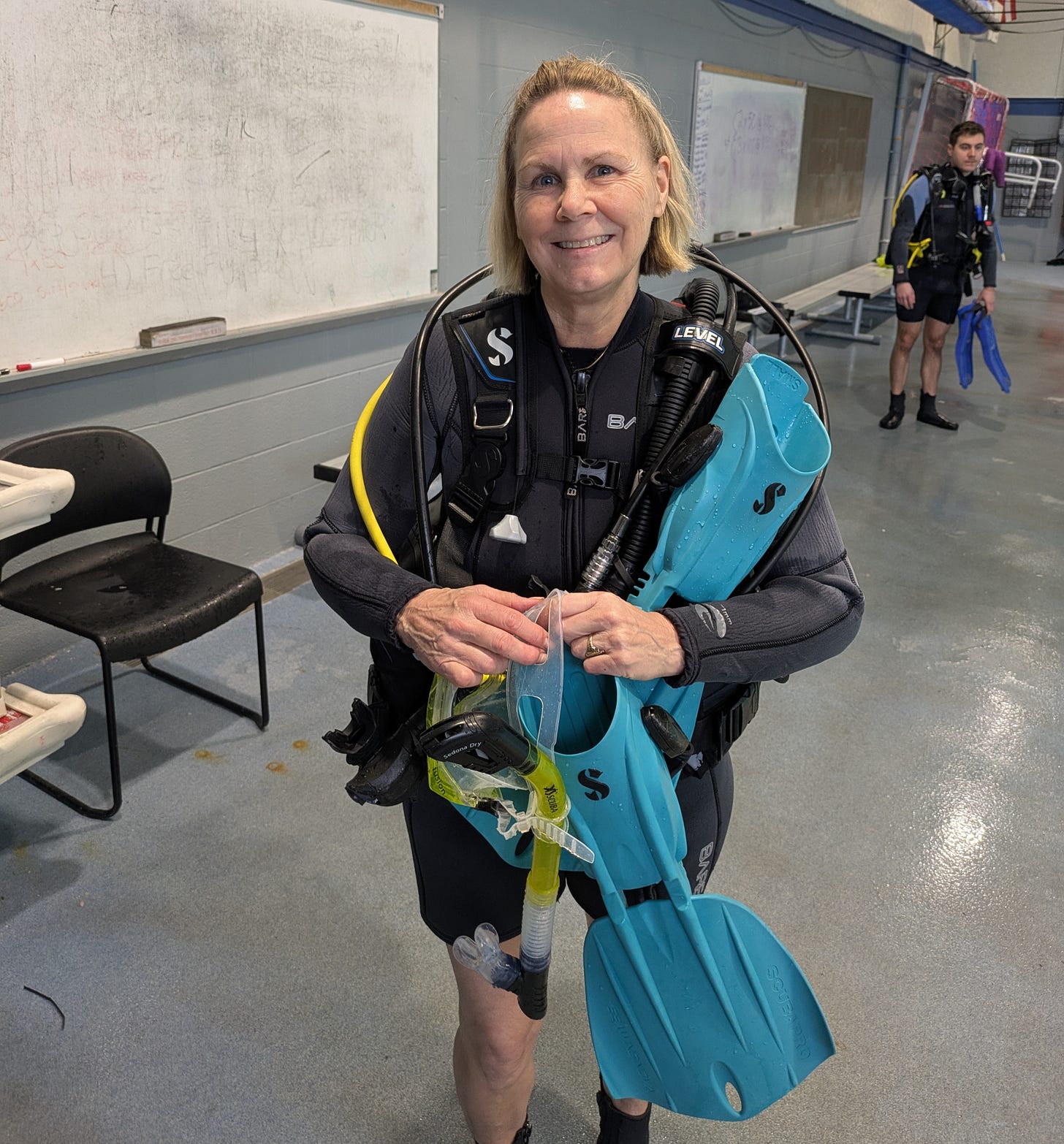I learned to scuba dive in high school. My open water certification dive was in Puget Sound on a cold Saturday in January. Our instructor promised that our wetsuits would keep us warm. They did not. He said that we’d see octopus, giant anemones, wolf eels, but who could see anything in that freezing, murky water? I was not a fan.
But scuba diving was something I was supposed to like. My father and two brothers were divers, and it fit in nicely with my image of an adventurous, living-on-the-edge kind of gal. So, when my dad, who was working in Saudi Arabia at the time, offered to take me diving in the Red Sea, I said, “Yes.”
The Red Sea is one of the most magnificent dive spots in the world. Beautiful coral, colorful fish, sharks, shipwrecks: the Red Sea has it all. I wouldn’t know. After five minutes underwater, I gave my dad the signal to go up. I wasn’t out of air. I‘d simply panicked.
There was so much that could go wrong. The equipment could fail. I could freeze and forget to breathe. What if I ascended too quickly and got nitrogen poisoning?
That was the last time I scuba dived.
(I did, however, write a children’s book about scuba diving).
A lot of time has elapsed since then. While I haven’t strapped on a scuba tank, My Guy and I have become avid snorkelers. We’ve been at it for so long that we remember when Playa del Carmen was a single dirt road and a bus stop. When the only lodging available in Akumal was a couple of concrete, thatched-roof huts with an old woman selling a stack of tortillas for a dollar from the back of her truck.
Some of my happiest moments have been meditatively floating on top of the water while a school of neon-colored fish swam by or thrilling to the sight of an eel, a shark, or a turtle. But when MG and I booked a trip to Tahiti, snorkeling didn’t seem like it was going to cut it. We needed to level up our game if we were going to wring every ounce of living out of our bucket-list trip to French Polynesia.
It was time to learn how to scuba dive. Again.
The perspective and wisdom I’d gained in midlife made me confident enough to believe that I could master my fears. Technology had changed, and so had I. This time, things would be different. I’d be calm and unafraid.
We plunked down a chunk of change on a scuba certification course, and over the next couple of weeks, spent our evenings completing the online portion. We’d talk flirtatiously at the dinner table about decompression, buoyancy, and the density of water versus air. When it came time for our weekend of in-pool training, we were ready!
Scuba diving is an equipment-intensive sport. First, there’s the Buoyancy Control Device (BCD), which looks a lot like the flotation devices found on airplanes. A regulator attaches to the BCD and delivers air from the tank into your lungs. There’s the tank itself and the all-important dive computer, which lets you know your depth and how long you can safely stay underwater. And, of course, after strapping 50 pounds on your back, it's time to put on your fins and mask. After learning how to assemble and put on this very sexy regalia, we were ready to jump into the pool. Excited? Yes! Mostly to relieve the pressure on our aching backs.
I’d like to put in a bit of a plug for scuba diving as therapy. So many of the skills we learned in our scuba class felt applicable to everyday living. Like if I mastered these rules, I could calmly address the waves that tossed my life around as well.
For example, the most important rule in scuba diving is to remember to breathe. Always. Our instructor couldn’t say it enough. If you aren’t taking in air, then you must be expelling it, sending a tiny parade of bubbles from your mouth marching up to the surface like a parade of ants. Sounds simple, doesn’t it? Am I the only person who holds their breath when they panic? Who wouldn’t benefit from taking a few mindful breaths throughout the day?
Rule #2: Clearly communicate with your partner. In other words, discuss the dive plan and make sure you both understand the hand signals before you go underwater. When you’re sixty feet below the surface and out of air, there’s no room for confusion or misunderstanding.
And that leads us to Rule #3: Ask for what you need – and be willing to help.
MG and I were dive buddies. Our instructor made us each practice swimming over to our partner from the bottom of the deep end, taking our regulator out of our mouths (scary!) and signaling that we were out of air. The other person would find their alternate breathing source, hand it to the person in need, and ask, using hand signals, if they were okay. Then, together, we’d slowly kick our way to the surface. One thing we’ve learned after so many years of marriage is how to work together. We aced that exercise.
It was the other stuff we had trouble doing. The two of us were continually popping to the surface because we couldn’t fully deflate our buoyancy control devices or exhale enough air from our lungs to sink to the bottom of the pool. We’d float around aimlessly like astronauts in space while the rest of the class lay prone on the floor of the pool, waiting for us to descend. We’d forget to breathe. Or breathe too rapidly and sheepishly hand over our tanks at the end of the session with most of the air gone. Neither of us felt comfortable carrying an extra 50 pounds on our backs.
Even with these bumps, My Guy and I embraced the lessons. A lovely fizz of energy would bubble up between us on our way home from the pool sessions as we talked about how fun it was to learn something new. I’d humble-brag to friends – and even commented on a
post – about the new skill we were learning. Pickleball? Salsa? Not us. We were learning how to SCUBA DIVE.
After we successfully completed the pool training, the only thing left in order to become certified was our open water dive. MG booked a two-day dive trip on a boat in Bora Bora, and I envisioned a whole new underwater world opening up to us.
A few days before we were set to leave, MG dug into our emotional luggage and brought out Rule #2. (Communicate clearly, remember?)
“Scuba diving is not for me,” he said. “My body aches. Frankly, I don’t think I’d enjoy it as much as snorkeling. If you want to go on the boat, you can, but I don’t want to.”
“You are my buddy…dive and otherwise. There’s no way I’d want to do this without you,” I replied, secretly pleased at my ability to string together such a sensitive and romantic response.
I’d love to score a few points for being an altruistic partner, but the truth was that I agreed with MG. I didn’t love the sport either. There was so much to think about underwater that I wasn’t sure I’d be able to enjoy the experience. Besides, my neck was killing me from carrying the equipment back and forth from the car to the pool.
We scrapped the open-water certification and cancelled the boat trip. The decision wasn’t cheap, but it was valuable in terms of what we learned about ourselves. It turns out we aren’t scuba divers after all.
I don’t for a moment regret taking the class – not the hours spent online learning or the weekends in the pool. The excitement we felt at learning something new together was real. So, too, was how empowered I felt at walking away.
We didn’t let fear stop us from saying yes, but we also didn’t let “should” stop us from saying no. This time it wasn’t fear that kept me away – just the feeling that there was something I’d rather do.
Snorkeling in French Polynesia? Well, it was amazing. I floated effortlessly in the warm water, watching schools of iridescent fish dart in and out of coral gardens of lavender, blue, and yellow. It was so achingly beautiful that I almost forgot to breathe. And, it didn’t matter.







As always, you leave me with lists to think on- even taking out my journal! Beautiful post. Thank you!
Kaarin, you two are so brave. I love to snorkel even though it’s been years but a life time ago, before kids, I went with friends to Grand Cayman. We snorkeled & it was beautiful. So you two crossed Scuba diving off your bucket list. Now you can really enjoy snorkeling wherever and whenever. Great read my friend! 🥰